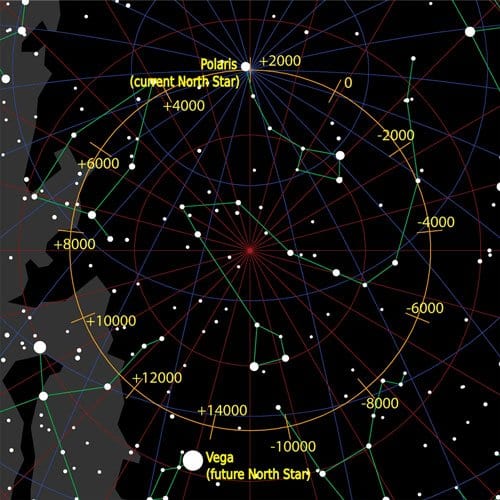
The returning darkness to our evening sky of late summer is dominated by one very bright star. Vega, high overhead in the tiny constellation Lyra, is more than twice the mass of our sun, but punches out a whopping 40 times the luminosity of our home star. And at only 25 light years (ly) away—just down the block, astronomically speaking—Vega’s tremendous luminosity punctuates our evening sky with a sharp blue-white brilliance.
Vega is very easy to locate at this time of year. Simply face south and Vega will be the brightest star almost at the zenith aka directly overhead. If the zenith were 12 o’clock, and the horizon in front of you were 9 o’clock, then Vega would be at about eleven-thirty, slightly to your left if it’s early evening. This will work even better if you look for Vega well before dark, as most other fainter stars will be eliminated. But Vega is difficult to miss—a beautiful blue-white beacon high overhead, brilliantly heralding the return of our deep dark skies.
When we look at Vega, we are looking in the direction that our sun and entire solar system travels at a rate of about 240 kilometres per second. We, along with the billions of other stars within the spiral arms, orbit around the centre of our galaxy. This centre, the super-massive black hole in the direction of Sagittarius that gravitationally anchors the rest of the galaxy, is off to your left, well below the horizon. Although we will never catch up to Vega, as it’s whizzing along ahead of us at breakneck speed around the galactic centre, we will, with gravitational tugs this way and that, get to within 17 ly of our neighbour. That won’t happen for more than 200,000 years, but Vega will then out-rival even Sirius, and be brighter than any other star in our sky, no matter the season.
But something quite intriguing will happen much sooner than that. Notice on a globe of our planet, how the two anchor points, located at the geographic north and south poles, define the spin of the globe. If you were to stand at the place on Earth represented by the upper anchor point on the globe, you would, of course, be standing at the north pole. The star Polaris (our North Star) would appear directly above you, at your zenith. Its position in the sky would never change from your zenith while our planet continued in its daily spin.
Well, almost never. In truth, our planet is like a spinning top that’s starting to wobble. So the spot in the sky that the axis of spin of our planet points to is constantly changing, or precessing, however imperceptibly slow that may be. This precession of our polar axis is slowly scribing an arc across the sky. In less than 13,000 years it will be pointing in the vicinity of Vega and Vega will become our new North Star! So be sure to stick around for that!
Likewise, when we look up at Vega, we are actually looking down onto its own polar axis. So if there are planets in orbit around Vega, and if one of them should harbour life, when that life looks up, our Sun will be their North Star!
Vega initially appeared in observations to be hotter than it should for a star of its size and type. But astronomers eventually determined that’s because it is spinning very rapidly. Our sun takes close to four weeks to complete one revolution at its equator. (Stars, being a gaseous plasma, flow more than spin, their equators travelling faster than near their poles.) Vega, on the other hand, completes the same in only 11 hours. This is fast enough that it is beginning to flatten a bit. Vega is 2.75 times the diameter of our sun through its equator, but only 2.25 times through its poles. So as we look down on its polar region, the surface we are looking at is closer to its interior where the heat from fusion is being produced. The surface at the poles is therefore much hotter than at its equator and, thus, the higher temperature observed.
Vega is a wild star living a fast and furious life. Being a larger star, it is fusing its hydrogen into helium at a prodigious rate. And at less than a half a billion years old, it is already halfway through its life. Within 500 million years, Vega will spend the last of its hydrogen (and perhaps some of its helium) and turn off. And without the outward thrust of fusion to counter the inward pull of gravity, the state of equilibrium will be broken. All the mass of Vega will then gravitationally collapse towards its centre.
It is difficult to imagine the inevitable “crunch” of all that matter meeting down in the centre, but, not surprisingly, the pressures and temperatures become great enough to break open the atoms themselves. With the electron “shell” of the atom breached, all the space that makes up the vast majority of the volume of the atom is now available. So all the nuclei of all the atoms can now utilize that freed-up space and keep collapsing and get packed down much closer together. And keeping in mind that it is in the nucleus of the atom where all the mass (the stuff that gravity acts on and makes things feel heavy) of matter resides, the end result is a star with a very small volume, but with a density hundreds of thousands of times that of ordinary matter.
Vega will then be what is known as a white dwarf star—not fusing anymore, but ferociously hot (upwards of 300,000 degrees Celsius), and very small (Earth-sized), but incredibly dense. A teaspoon of the “stuff” of these stars weighs tons. Vega will then have met its endgame. It will remain unchanging as it slowly cools over billions of years.
Our sun is destined for the same fate, but, consuming its nuclear fuel at a much more conservative rate, will live 10 times longer and be around for billions of years after Vega is long gone.
So do get out in the early evening and say hello to our tempestuous, but fascinating neighbour while you still can.




